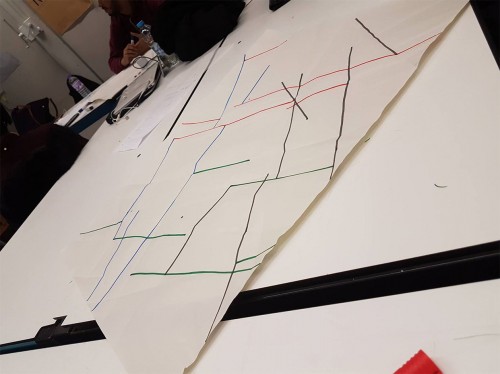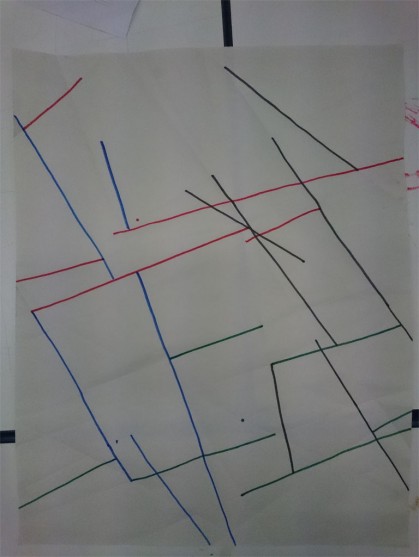Conditional Design is a design method formulated by the graphic designers Luna Maurer, Jonathan Puckey, Roel Wouters and the artist Edo Paulus which foregrounds process over finished products. As a design strategy, it is defined by playfully designed sets of rules and conditions that stimulate collaboration between participants and lead to unpredictable outcomes.
Manifesto for artists and designers by Moniker
Through the influence of the media and technology on our world, our lives
are increasingly characterized by speed and constant change. We live in
a dynamic, data-driven society that is continually sparking new forms of
human interaction and social contexts. Instead of romanticizing the past,
we want to adapt our way of working to coincide with these developments,
and we want our work to reflect the here and now. We want to embrace the
complexity of this landscape, deliver insight into it and show both its beauty
and its shortcomings.
Our work focuses on processes rather than products: things that adapt to
their environment, emphasize change and show difference.
Instead of operating under the terms of Graphic Design, Interaction Design,
Media Art or Sound Design, we want to introduce Conditional Design as a
term that refers to our approach rather than our chosen media. We conduct
our activities using the methods of philosophers, engineers, inventors and
mystics.
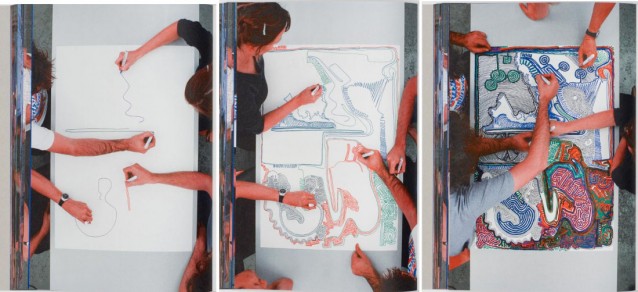
Conditional Design Research Example
Example 1. Four Long Lines
Play with 4 players
Each player has a coloured pen: Red, Blue, Green, Black
The players draw simultaneously
Rule:
- Draw 1 long line during 1.5 hours.
- The pen may not leave the paper during the entire time.
- You may stop for a maximum of 5 seconds without lifting the pen.
- Do not cross any other lines.
Example 2. Custom Rules
Player with 4 players
Each player has a coloured pen: Red, Blue, Green, Black
The players take clockwise turns
Rule:
- First round, each player: Draw 1 straight line with a maximum length of 10cm near the center of the paper.
- Following round, each player: Choose one sentence from both cards by underlining one of the options.
- Next turns, draw a straight line following the two rules you have chosen.
- Only draw a line if it does not conflict with the two rules you have chosen.
- Do not cross other lines unless explicity stated otherwise.
- Stop drawing when you have reached the edges of the paper.
Workshop
Example 3. Decode & Recode
Exercise 2: Hatching
Player with 4 players
Each player has a coloured pen: Red, Blue, Green, Black
Each player places a dot on the sheet at an arbitrary position but not further than 10 cm from each other
The player take turns in clockwise
Rule:
- The line must connect two dots.
- The angle of the line must be within the following range: 0 to 45 degrees for the black lines, 45 to 90 for blue lines, 90 to 135 for red lines, 135 to 180 for green lines.
- Connect the line to an existing line if possible.
- Draw the shortest possible line from your starting point. If you enclose an area then hatch it with lines parallel to the line you enclosed the area with. The enclosed area may not contain unconnected dots or open ended lines.
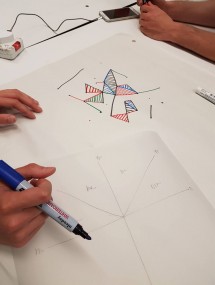
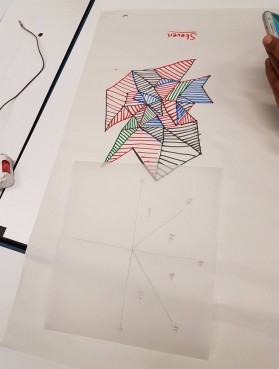
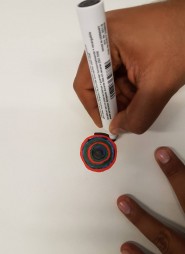
Exercise 1: The Perfect Circle
Player with 4 players
Each player has a coloured pen: Red, Blue, Green, Black
The player take turns in clockwise
Rule:
- Player begins by drawing a circle on the centre of the paper.
- End each turn with a perfect circle which is larger than the previous one.
- Each person must take 60 seconds to take their turn.
- Finish when you reach the end of the page.
Exercise 3: The Beach
Player with 4 players
Each player has a coloured pen: Red, Blue, Green, Black
The player take turns in clockwise
Rule:
- Each turn, find the most empty space on the paper
- Each turn place a dot in the middle of the empty space
- Do it as quickly as possible in 5 minutes.
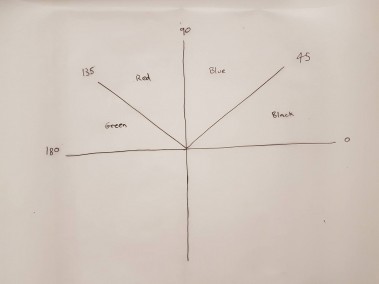
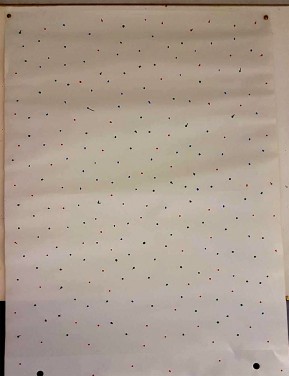
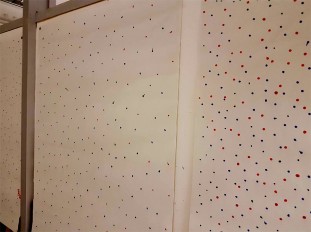
Exercise 4: FluxFold
Player with 4 players
Each player has a coloured pen: Red, Blue, Green, Black
The player take turns in clockwise
Rule performed the first turned by each player:
- Life corner of the paper from the table and bring it to any place on the paper so that one other corner must be lifted too.
- While keeping the corner at its position, press the paper flat and make a fold.
- Unfold the paper again to its standard position.
- Place a dot somewhere on the fold.
FOLDING THE PAPER
- Bring corner of the paper to the end of the line drawn by the player on your right.
- If the player has only placed a dot, bring the paper to that dot.
- While keeping the corner at its position, press the paper flat and make a fold.
- Unfold the paper again to its standard position.
- If the fold is almost parallel to the edge of the paper, place some small dots at the ends of the fold, so to clearly mark it as your fold.
DRAWING THE LINE
- Start the line at the end of the last drawn line
- The line should always follow a fold.
- The line may cross other lines but it may not be on top of other lines.
- The end of your line should always be where one of your own folds crosses a fold by someone else.
